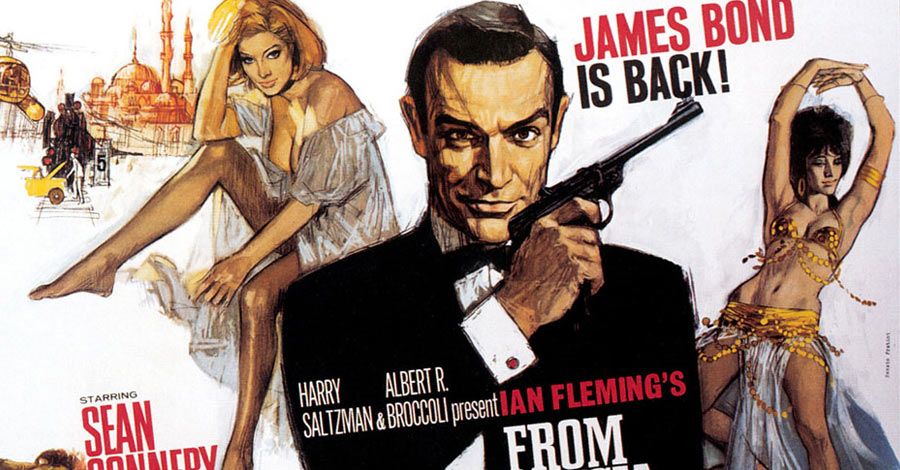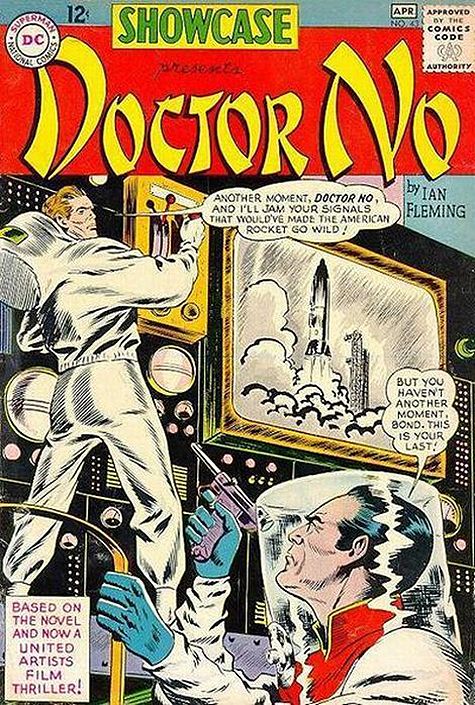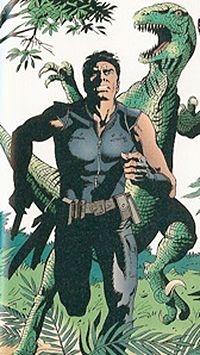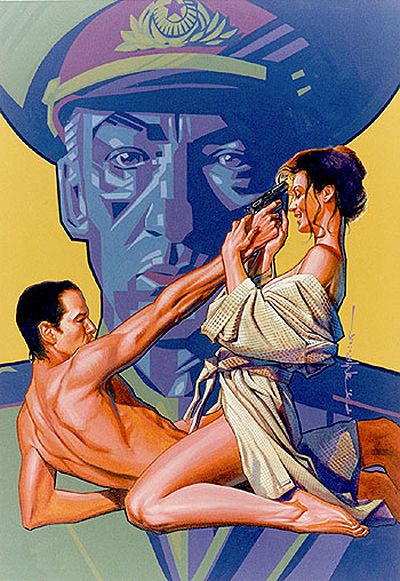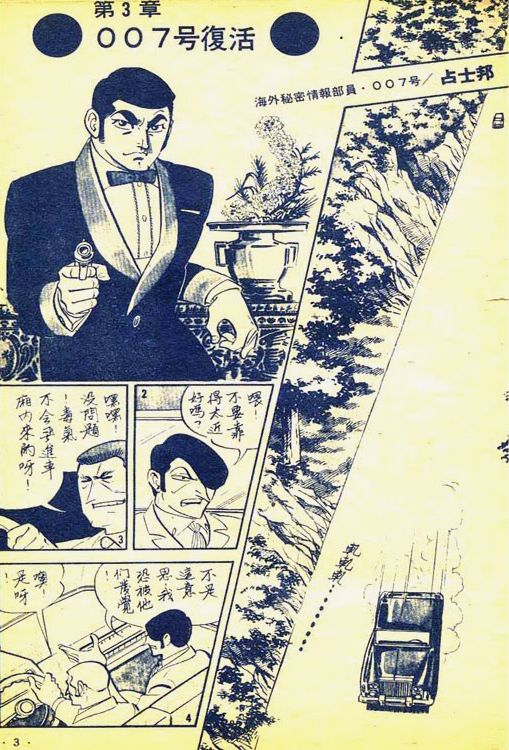James Bond Will Return In...
And so Dynamite Entertainment have picked up the comics license for James Bond, returning the martini-drinking, pun-using, self-loathing 00-agent to the comic book page. Aside from a few cameo appearances, this marks the first time in several years that the spy has shown up in a licensed comic in the United States. Considering his imminent return to the printed page, now seems like the perfect time to dive into James Bond's interesting comic book history.
His first comic appearances were in a strip running in UK newspaper The Daily Express. In 1957 -- five years before the first film, "Dr. No," came out -- the newspaper approached creator Ian Fleming about the possibility of turning his adventures into a comic strip. Fleming wasn't particularly keen on the idea, and is reported as writing:
"The Express are desperately anxious to turn James Bond into a strip cartoon. I have grave doubts about the desirability of this ... Unless the standard of these books is maintained they will lose their point, and, I think, there I am in grave danger that inflation will spoil not only the readership, but also become something of a death-watch beetle inside the author. A tendency to write still further down might result. The author would see this happening, and disgust with the operation might creep in."
He did, however, eventually relent, and the first strip began in 1958. It was an adaptation of "Casino Royale", the first story in the continuity of the Bond novels, and was put together by writer Anthony Hern and artist John McLusky. Proving a success, Henry Gammidge came aboard as the strip's writer once "Casino Royale" wrapped, subsequently working with McLusky for over a thousand subsequent installments of the strip and adapting many other "Bond" novels in the process.
The success of the stories led to competition, however, which Fleming spurred on. Noting the demand for the stories, he sold "The Living Daylights" to The Times rather than The Express, leading to a public falling out between Fleming and The Express' editor. At the time, The Express had been partway through adapting "Thunderball"; that serial was never properly completed as a result.
Things were eventually patched up and the Gammidge/McLusky team continued on to produce a second volume of James Bond stories. Their run ended in 1966, with Jim Lawrence and Yaroslav Hovak taking over to finish out the remaining Bond book adaptations. When they ran out of stories to adapt, the Fleming Estate -- Fleming himself having died in 1964 -- allowed them to start creating their own stories instead; the first was called "The Harpies." This third volume of James Bond strips lasted for over a decade until The Express discontinued them in 1977.
Undeterred, the duo of Lawrence and Hovak simply moved their stories across to other newspapers like The Daily Star. They even invited original artist McLusky back for a three-year run. Ultimately, The Daily Star also discontinued the series, with the last strip running in 1984. That's not the end of their publication, though, as Titan Books have started collecting these strips in omnibus form, with volume six of their collected editions solicited for release in November.
The strips were syndicated across Europe, but it was in Sweden that the stories grew most in popularity. Semic Press set up a James Bond magazine in 1965, which translated the strips into Swedish and published them in comic book form. That meant they ran through the stories fairly quickly, and by the 1980s had translated everything that The Daily Express and Daily Star had published. Undaunted, they decided to acquire the Swedish rights to make new stories themselves, and between 1982 and 1991 Semic Press put out close to 50 new James Bond stories. That volume of output makes Sweden the unofficial home for Bond comics.
Dynamite Acquires James Bond License, Plans Origin Comic In 2015
The very first James Bond comic in the US came about as an adaptation of the first Sean Connery movie, "Dr. No". Published first in the UK by Classics Illustrated, it was picked up by DC Comics and published within their 1963 "Showcase" anthology series. Strangely enough, however, DC also bought the US license to make James Bond comics -- but never used it. This may have been because the films were slow to take off in America. Even as both Sean Connery and the Bond films began to become a worldwide phenomenon in the following years, the character remained in limbo within the comics industry.
Once DC's ten-year option expired, there was still seemingly no interest in picking up the license. It wasn't until well into the Roger Moore era of films -- where the character started adapting more to the cinematic trends of the time and thus also started to pick up greater attention in America -- that the character made a return to comics. In 1981, Marvel picked him up, dusted off his powder blue leisure suit and adapted "For Your Eyes Only" -- which may be one of the least memorable of the movies. For anyone wondering, this was the film where James Bond completes his mission with the help of both Carol Bouquet and a talking parrot.
The creative team behind this two-issue adaptation of the movie was an incredibly strong one, as writer Larry Hama and artist Howard Chaykin worked with inker Vince Colletta under the eye of Denny O'Neil. By any account, that's a damn strong creative team. The book saw a reasonable level of success as well, leading to an "Octopussy" adaptation two years later. Once that adaptation was completed, however, Marvel's involvement with the franchise ended.
The rights instead headed to Eclipse, who adapted "License to Kill" with Richard Ashford and Mike Grell. Following that series, Grell started work on creating an entirely new James Bond adventure that he would both write and draw called "Permission to Die." This new series was weighed down by fluctuating artwork and a strange story filled with flashbacks and gypsy camps. The first issue saw print in 1989, but It would be two years before the final issue came out. The delayed release of the story led to the US license once again floating adrift.
In 1992, Dark Horse Comics picked up the James Bond license and published six Bond stories in five years. Not all of these new stories were completed, though; "A Silent Armageddon" saw severe delays in the art schedule, which meant issue four of the four-issue miniseries never came out. This was perhaps for the best, because the story was apparently to feature a virtual reality scene where a thirteen year old girl was aged-up in order to became Bond's latest love interest.
"Armagddon" aside, some bizarre, fascinating, and incredible Bond stories came out during this time. There's Dark Horse Comics' 1992 limited series "Serpent's Tooth" by Doug Moench and Paul Gulacy, for example, which is best known for the scene in which Bond fights a velociraptor. It all makes sense within the story itself, mostly. The quality of each book during the early '90s was highly variable, although this era does feature work from creators like David Lloyd and Don McGregor -- who produced "The Quasimodo Gambit" for Acme in 1995.
Things get stranger still with 1996, though, as Topps Comics took on the license for the most recent James Bond story. Yes, it's been almost twenty years since we last saw an official James Bond comic in the US. An attempted adaptation of "Goldeneye," the most current Bond film at the time, quickly became a cursed production; the series never got past the first issue. Officially, Topps said that this was because they couldn't get permission to use Brian Stelfreeze's faintly explicit cover for the second issue, which lead to lengthy delays in production.
James Bond today is one of the true survivors of film history, with Daniel Craig's reinvention of the character putting him right back at the top of the genre. James Bond comics have now been published around the world. There have been substantial Bond runs in Spain, India and a number of spin-off comics like Marvel's "James Bond Jr," which was based on the cartoon series of the same name. Bond has also been published into four Manga from Takao Saito, a creator best known for his own long-running spy series "GOLGO 13." Saito's work with the character began with an original story titled "It Is Them To Die."
Most recently he's been seen in the UK for an adaptation of Charlie Higson's "Young Bond" story "SilverFin," which featured artwork by "Thunderbolts" and "Avengers Arena" artist Kev Walker. Bond also made an unofficial appearance in 2007's "The League of Extraordinary Gentlemen: Black Dossier," in which Alan Moore was... perhaps not the kindest about him. But in terms of official comics for US fans, things have been quiet for a very long time indeed.
So as we speed into the present day and the news that Dynamite now have the James Bond license, time will only tell what we'll see from it next. They've said they're going to tell stories of Bond's origin and his first few steps in the world of espionage, but will he fight a dinosaur this time round? We'll have to wait and see.

